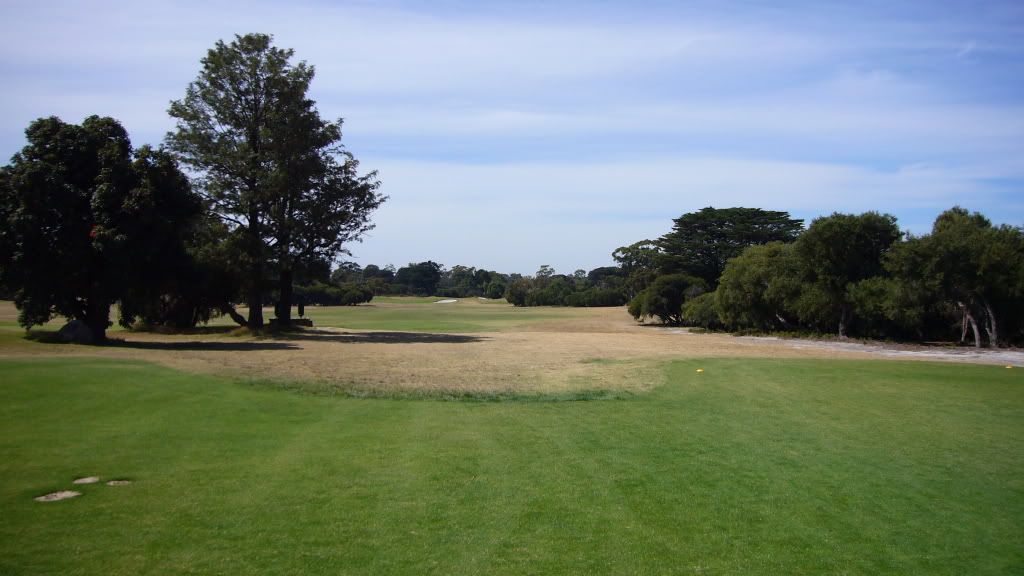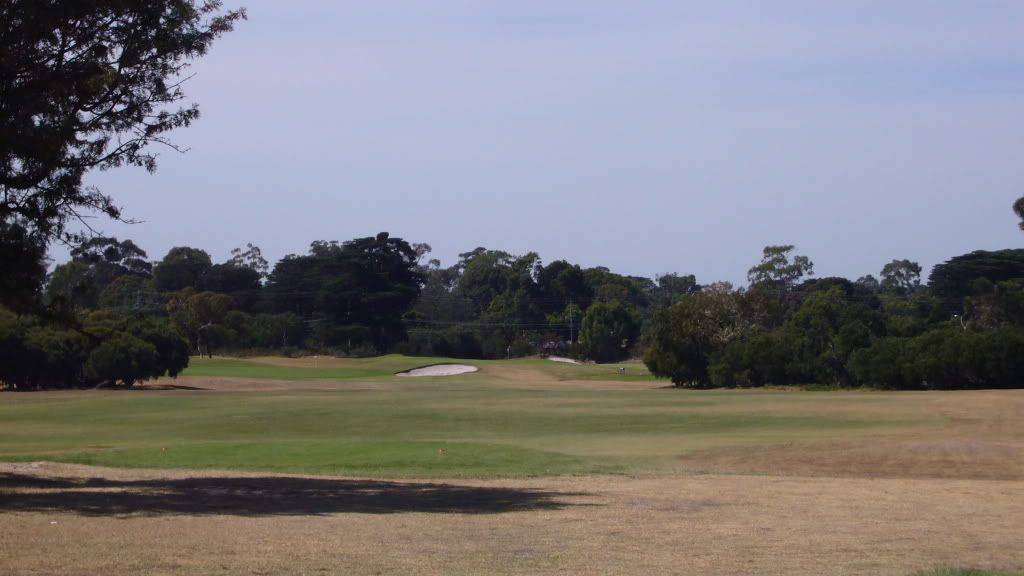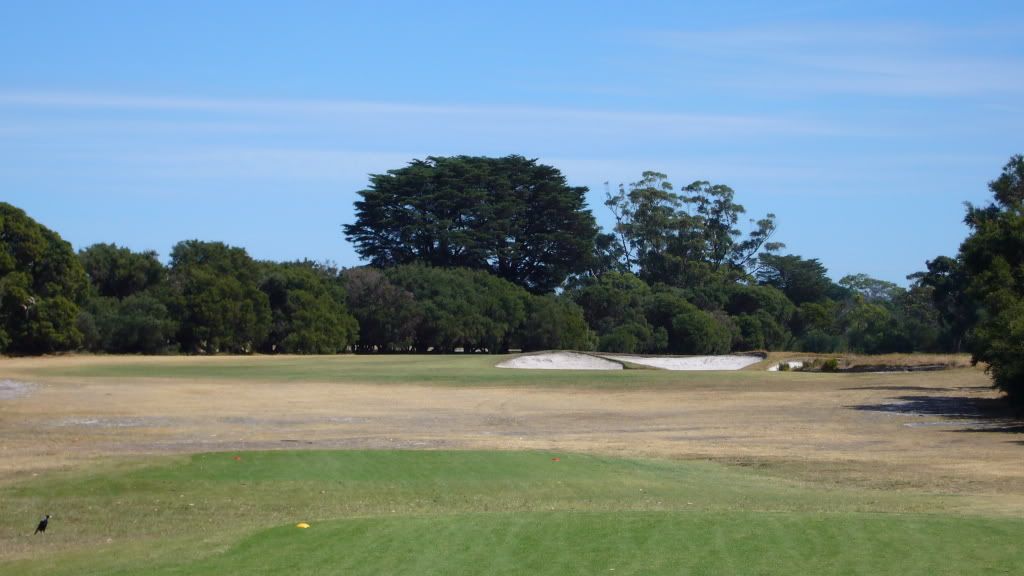It is, by far, the greatest course I ever have played: the 12 holes from the West course combined with 6 from the East into a powerhouse.
Why is it great? Because in my personal experience:
- It offers plenty of width, zero repeat zero water (= death) hazards yet does not come within 24,000 miles of boring. It is the course that proves playability, fun, challenge, and "championship test" all can be mentioned in the same sentence. It is the course that, perhaps outside TOC (perhaps not), shatters all these forced compromises the most thoroughly. It is a course that renders the hypothetical real and therefore I (a layman) would imagine Royal Melbourne to be of priceless architectural merit. (Note the distinction to historical or cultural merit.)
- It has more great holes than any other course I've played, and for their class, (using the West / East hole designations here) RMW3, RMW5, RMW6, and RMW10 lay a claim as possibly the best in my experience. Honestly, someone could name any hole as their favorite on the course, possibly even in his opinion the best on the course, and with one exception I would not blink an eye. And that exception is pretty good -- not only that, but I have had conversations with members who argue the point. But even there, in those conversations they agree there's just one weak hole. They just pick the other hole which might be "just okay" -- one which I like very much!
- The mix of holes, from the par 3s (given there are only three) to the best collection of short / medium 4s I've ever seen and ditto for long 4s / par 4.5s, is without peer. When you play the Composite the holes go from strength to strength.
- A great drive merely privileges you to accept a greater challenge. It is necessary, but insufficient, a condition which surprisingly leads to great pressure on the driver, yet there are few dramatic carries involved, certainly nothing pornographic in a golf sense. The drama is between your ears. You simply must put the ball in the right spot, but for that accomplishment you simply get the chance to try something really difficult -- if you are going for a score.
- The routing finds excellent locations for the greens and provides some fun tee shots. Honestly, though, I have a weird test for a routing: disorientation. I find the courses I get the biggest kicks out of are ones where I always seem to be in a different place than I am. Another way to put this is when you see the clubhouse or another hole and wonder, "What is that doing THERE?" I find it amazing how Mackenzie not only found the green site for RMW 7 {note: not a Mackenzie hole, see Neil C's reply below}, but how he found a way to fit all those other great holes around it! I still get disoriented walking down RME 17 and seeing that big bunker-infested hill on RMW4. RME17 green looks like a different green when viewed from RMW1. And I must insist that RME18 is NOT the same hole you see from RMW1 tee! As these bizarre anecdotes suggest, there's an economy in the routing (discussed in the post on the Composite 3rd (RME1). And the property might be the best I ever have seen for golf, including linksland. Sandy soil with lovely movement.
- The architects and caretakers got the little things right, like mounding, bunker style, panoramic vistas.
- The greens are utterly fascinating and worthy of endless study.
- The bunkering is beautiful, and one in particular is the most-amazing I ever have seen or possibly ever will see. It is like a little diorama, a microcosm, of what deep down the game of golf is all about.
- It has a rich history, including professional tournaments as well as its alluring genesis.
- It is not a million miles long, or even a million kilometers long. Not yet, anyway.
This is not to say the course is perfect. As pictures show, it has suffered from the drought. (The club has built a massive reservoir that should improve fairway conditions.) And the ti-trees need to be pruned back in spots. Then there's that matter of one hole being merely okay...
I will try to note the many great things in the pictures, but honestly there's a lot to remember. Not only that, I probably have misremembered some of the history and anecdotes -- sorry!
1st hole (RMW 1): 429-yard par 4. We start with the famously wide fairway, but as with much out here, there is a lot more than meets the eye. The right greenside bunker stands sentinel over the tee. Best to drive out to the left, which requires the golfer to challenge the ti-trees. These trees by the way originally were not there but were introduced to protect golfers coming up the Composite's 18th hole, which runs parallel (reverse) left. There is rough over there but if the hole is located anywhere to the right, that's a better place to be than having to challenge the bunker.
So the golfer who wants a 4 really needs to place his tee shot carefully in this massive fairway, and he needs to think about the location of the flag. The size of the greens makes hole location a meaningful factor. For example, if it's anywhere near the bunker, the golfer really needs to get over to the left.
Right from the start, we see a good drive is required just so the golfer is given the privilege of a challenging shot. In other words, a good drive invites a challenge. This is the essence of the scoring test, at least from tee to green. It's the golfer who seeks to post a number who will feel the vise tighten. A golfer content to play for a 5 plays his second shot short and left, avoiding the bunker, and pitches up. This pitch is anything but straightforward however: a subtle hollow in front of the green (there's a larger one in the back) can set the small muscles twitching. And there's so much green to negotiate, that's another little math problem the golfer must solve.

1 Green -- as with all the greens out here, the size and contour offer a stern defense, and the cleverly-placed bunkers must be avoided if the golfer hopes for a score. That's the green front left -- the second green is RME 17. This type of disorienting vista, where more than one green is not only visible but on or near the line of vision, is common here.

The tee for the 2nd hole (RMW 2) is reached by a short walk behind 1 green. 480 yards and played as a par 5 for members and a 4 for the pros, the golfer must decide if his game and the wind allow an aggressive route over the heavily-bunkered corner. The hole is Z-shaped with a strategy similar to the 5th hole at Bethpage Black: a safe route to the left is available, but that condemns the golfer to a 5 at best.

The golfer who takes the aggressive route and succeeds receives not a "reward" but rather a sterner test: does he go for the green? Confoundingly, this green is heavily canted to the left, yet does not appear nearly so. In practice this means the green must be approached from the right. Under firm and fast conditions, the green complex cannot be attacked via a simple air route. Bunkers left and right must be avoided at all costs, but especially the right bunker as it sits higher than the green. The speed of the greens renders their playing size much smaller; chips, pitches and sand shots to greens running away from the golfer are very, very difficult up-and-downs. Of course, because the play is to the right, the perfect entrance just a narrow slot, the golfer finds himself unnerved by having to aim at the bunker he absolutely must avoid!
Just a very challenging shot, one of those you've got to see in your head then really commit to. Hard to believe, but the back left flag in the picture below must be "attacked" via a shot that lands well short and right.

Bedtime -- I will try to get to the rest of the holes over the holidays, sorry for the piecemeal approach!
Mark